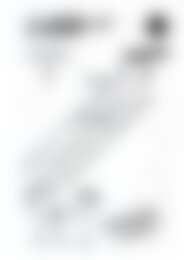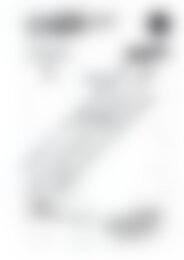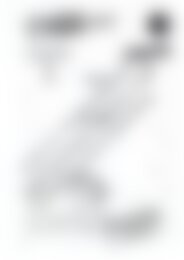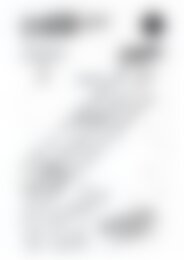RIC-3531 Primary Science - Book D (Digital)
You also want an ePaper? Increase the reach of your titles
YUMPU automatically turns print PDFs into web optimized ePapers that Google loves.
A Whirligig<br />
Flight – Activity 3<br />
Lesson Focus<br />
Outcomes<br />
Energy and change<br />
2.5 Describes properties of<br />
light, sound, heating and<br />
movement.<br />
Indicators<br />
• Makes predictions about<br />
flight patterns of the<br />
whirligig.<br />
• Constructs and throws a<br />
whirligig.<br />
Skills Focus<br />
• Predicts<br />
• Observes<br />
• Draws conclusions<br />
• Conducts simple tests<br />
Background Information<br />
Four basic forces are involved<br />
in flight – gravity, lift, drag and<br />
thrust. Thrust is created by<br />
a plane’s propellers or its jet<br />
engines. Drag is the natural<br />
force of air resistance against<br />
the plane’s forward movement.<br />
Lift is created by the plane’s<br />
wings as they move through<br />
the air and gravity is a natural<br />
force that pushes the plane<br />
towards the ground. Gravity<br />
and lift are opposite forces, as<br />
are drag and thrust.<br />
The ‘whirliggig’ flies through<br />
the air because of the force<br />
used when it is thrown. It spins<br />
and cuts through the air in<br />
the same way as a propeller.<br />
It works best when held by<br />
the end of one of the blades<br />
or wings with the thumb and<br />
index finger.<br />
Keep the whirly-gig vertical<br />
and flick forward and upward<br />
to start a spinning action. It<br />
should return in a semicircle<br />
and come back to the place it<br />
was thrown from. It may take<br />
several practices to get the<br />
correct thrust to make it return.<br />
Safety Warning<br />
Do not aim flying objects at<br />
any person.<br />
Always test flying objects in<br />
safe conditions and areas.<br />
Fly them away from people<br />
or windy conditions.<br />
Before the Lesson<br />
Materials Needed<br />
Stiff card (e.g. cereal packs – other materials such as cardboard, styrofoam or<br />
balsa can also be used), whirligig template (page 81), scissors.<br />
Preparation<br />
• Have templates already made in thick card for students to trace around.<br />
• Make a model whirligig and practise throwing it to demonstrate and discuss<br />
results.<br />
• Students will need a large area like a gymnasium, an undercover assembly area or<br />
oval to practise throwing their whirligig (little wind).<br />
• Have a collection of pictures of aircraft with propellers or rotor blades on display<br />
(as in gyrocopter activity).<br />
The Lesson<br />
Stimulus<br />
• Discuss pictures where aircraft use propellers or rotor blades.<br />
What to Do<br />
• Students trace around a whirligig template onto card.<br />
(See ‘Appendix 1’ on page 81.)<br />
• They carefully cut around the shape so the edges are smooth.<br />
• Students can colour it brightly and add their names.<br />
• Ask students to predict what they think will happen when the whirligig is thrown.<br />
• Demonstrate how to hold and throw the whirligig for students by holding one<br />
blade vertically and flicking it forward and upward.<br />
• Students will need to practise to get the correct amount of thrust to make the<br />
whirligig circle and come back like a boomerang. (Students will need a large area<br />
to practise—preferably indoors without wind.)<br />
• Students record what they have found about their whirligig.<br />
• Try throwing the whirligig horizontally. What happens?<br />
• What could be changed to make it better? Allow students to experiment and<br />
record results.<br />
• Talk about the performances of the whirligigs.<br />
• Ask who can throw and catch their whirligig. Give each throwing technique a<br />
rating.<br />
After the Lesson<br />
Answers<br />
Teacher check<br />
Additional Activities<br />
• Make a frisbee using an aluminium pie plate and modelling clay. Turn the plate<br />
upside down and try to fly it. What happens? Add small amounts of modelling clay<br />
evenly spaced around the outside edge of the dish. Using a backhand toss, try to<br />
fly it again. Is it better with or without the weights? Try different types of plates<br />
or alter the weights used. What differences can you notice? Record results and<br />
compare with others in the class. Hold a competition for the longest flying pie<br />
plate design.<br />
• Make small finger boomerangs (from stiff card) that can be launched off a slightly<br />
tilted book with the flick of a finger. Strike the boomerang so that it spins off<br />
the book rapidly. The boomerang should fly straight out, turn and come back. If<br />
needed, give one edge of each wing a slight bend upward like a forward flap.<br />
Display Ideas<br />
• Research and display pictures and reports showing the uses and<br />
types of boomerangs. Do they all return?<br />
76 PRIMARY SCIENCE ~ R.I.C. Publications ® ~ www.ricpublications.com.au<br />
ISBN 978-1-925660-54-8<br />
©R.I.C. Publications<br />
Low Resolution Images<br />
Display Copy










